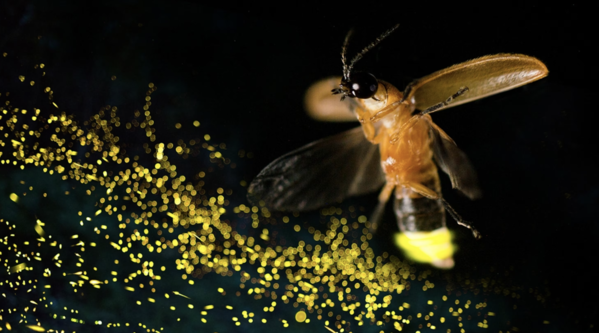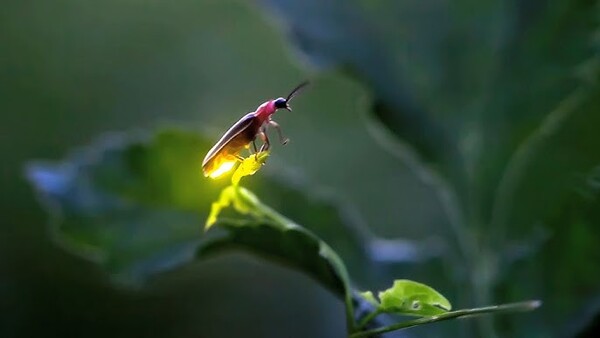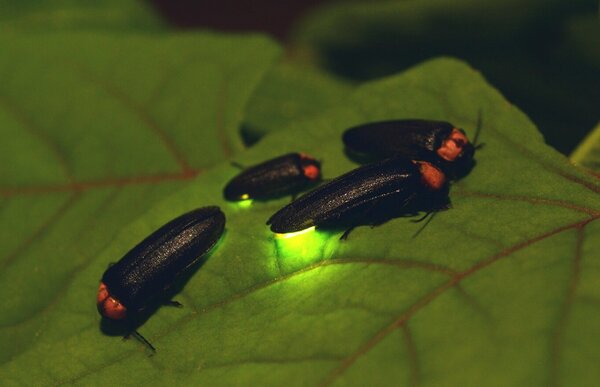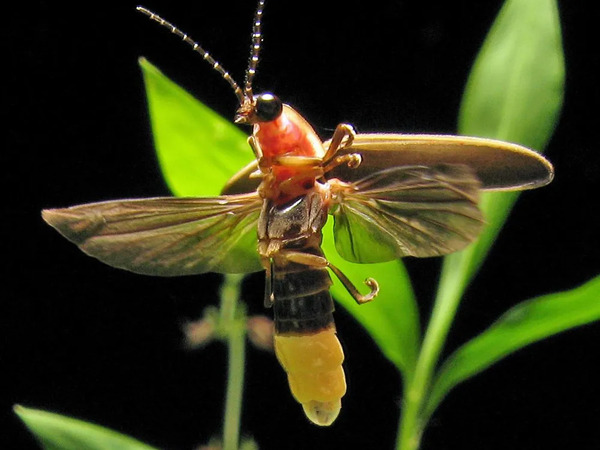Fireflies, also known as lightning bugs, are small beetles famous for their ability to produce light through bioluminescence. These fascinating insects captivate people around the world, especially during warm summer nights when they flash and glow in fields, forests, and gardens. Let’s explore everything you need to know about fireflies, from how they glow to their unique life cycle and habits.

Fireflies belong to the Lampyridae family and are found in various regions worldwide, particularly in warm, humid areas. They are not actually flies; rather, they are beetles with unique adaptations that set them apart from other insects. Fireflies are most known for their bioluminescent abilities, allowing them to light up at will.
Key Facts:
Scientific Family: Lampyridae
Habitat: Wetlands, fields, forests, and near water sources
Diet: Varies by life stage; primarily carnivorous as larvae, with some adults feeding on nectar, pollen, or other fireflies.
The firefly’s glow is a result of bioluminescence, a chemical reaction that occurs in the insect’s lower abdomen. When a substance called luciferin combines with oxygen, it produces light. This glow is often green, yellow, or pale red depending on the species.
Why They Glow:
Communication: Fireflies flash to communicate, particularly to attract mates. Each species has a unique flash pattern to help males and females recognize each other.
Warning: Fireflies produce a bitter chemical as a defense mechanism. Their glow can serve as a warning to predators that they’re not tasty.
Hunting: Some species use their light to attract and hunt other insects.
Fireflies go through a complete metamorphosis, meaning they have four life stages: egg, larva, pupa, and adult. Each stage brings changes in behavior, habitat, and diet.
Egg: Fireflies lay eggs in moist soil, usually in late summer. Eggs hatch after about three to four weeks.
Larva: The larval stage lasts for up to two years, during which they are voracious eaters, preying on snails, slugs, and other small insects.
Pupa: After the larval stage, fireflies enter a pupal stage, lasting up to three weeks as they transform into adults.
Adult: Adult fireflies typically live for about two months. Their main goals are to reproduce and find mates.

what do fireflies eat? Here, we'll dive into the dietary habits of fireflies, which can vary widely depending on their life stage and species.
Before exploring what fireflies eat, it's essential to understand their life cycle. Fireflies go through several stages: egg, larva, pupa, and adult. The diet of fireflies changes significantly from larvae to adulthood. Firefly larvae are known to be much more voracious eaters, while adult fireflies have different dietary habits.
When fireflies are in the larval stage, they are often found in moist environments, such as soil, leaf litter, or near bodies of water. During this stage, firefly larvae are carnivorous and primarily feed on other small creatures. Here’s a breakdown of their favorite foods:
Small Insects: Firefly larvae prey on small insects, including worms and soft-bodied insects.
Snails and Slugs: They are especially fond of snails and slugs, which they can easily consume with their mandibles.
Earthworms: Firefly larvae may also consume earthworms when they find them in the soil.
Fun Fact: Firefly larvae have a unique way of hunting. They inject their prey with digestive enzymes, which break down the body, allowing the larvae to suck up the nutritious fluids.
Adult fireflies have a very different diet than larvae and are often less interested in food. In fact, some adult fireflies don’t eat at all and focus on reproduction. However, for those that do consume food, their diet generally consists of:
Nectar and Pollen: Some adult fireflies feed on nectar and pollen, which provides them with enough nutrients for survival.
Plant Material: Certain species may nibble on plant material, though this is relatively uncommon.
Other Fireflies: In a surprising twist, some adult fireflies are predatory. In particular, Photuris females, often called "femme fatales," mimic the light signals of other fireflies to attract and consume them.
Yes! Firefly larvae, by feeding on snails, slugs, and other insects, can help in controlling these populations naturally. This diet makes firefly larvae beneficial for gardeners, as they help keep pest populations down without the need for pesticides.
If you're interested in observing fireflies or raising them, it’s essential to understand that fireflies, especially as adults, have very specific diets and may not require much food at all. Firefly larvae need a diet of small insects, which can be challenging to replicate outside their natural environment.
| Life Stage | Diet |
|---|---|
| Egg | None (eggs do not consume food) |
| Larva | Carnivorous – snails, slugs, small insects, earthworms |
| Pupa | None (pupae do not consume food) |
| Adult | Varies by species – nectar, pollen, other fireflies, or may not eat at all |
Protecting fireflies and their habitats benefits our ecosystems in several ways:
Natural Pest Control: Firefly larvae help control pest populations.
Biodiversity: Fireflies add to the biodiversity of ecosystems and play unique roles in their environments.
Scientific Research: Studying bioluminescence in fireflies has led to medical advancements in disease research, including cancer detection.
Fireflies are more than just beautiful, glowing insects; they are unique predators and natural pest controllers. Whether you're seeing fireflies flash in a field or marveling at their larvae hunting in a garden, knowing what fireflies eat gives us a better understanding of these fascinating creatures. Protecting their natural habitats ensures we can enjoy their magical lights for generations to come.

Fireflies have over 2,000 known species. Each species has a distinct light pattern and varies slightly in size, color, and behavior. A few notable types include:
Photinus: The most common species in North America.
Photuris: Known as “femme fatale” fireflies, these females mimic other fireflies’ flash patterns to attract and eat them.
Pyractomena: Known for their orange glow.
Fireflies play an essential role in ecosystems. As larvae, they help control populations of snails, slugs, and other insects, making them beneficial for gardeners. Fireflies are also part of a larger food web, serving as prey for birds, frogs, and other animals.

Firefly populations are declining due to habitat loss, pollution, and light pollution, which disrupts their mating signals. Conservation efforts focus on:
Reducing artificial lights: Encouraging the use of less outdoor lighting at night to protect their flashing signals.
Preserving wetlands: Protecting their natural habitats like fields and marshes.
Limiting pesticide use: Avoiding chemicals that harm firefly populations and their prey.
Fireflies have fascinated people for centuries and often appear in folklore, art, and literature. Their unique ability to produce light has even inspired scientific research, leading to advancements in areas such as medical imaging and disease detection.
Fireflies are the only land animals that use bioluminescence to communicate visually.
Different species of fireflies have specific “flash codes” that help them find mates.
Some fireflies can regulate the intensity and pattern of their flashes.
| Characteristic | Detail |
|---|---|
| Scientific Family | Lampyridae |
| Glow Color | Usually green, yellow, or red |
| Diet (Larvae) | Small insects, snails, slugs |
| Diet (Adults) | Nectar, pollen, or other fireflies (varies by species) |
| Lifespan (Adult) | About 2 months |
| Habitat | Wetlands, fields, forests |
| Major Threats | Habitat loss, light pollution, pesticide use |
Fireflies are enchanting insects that bring beauty and biodiversity to their habitats. Protecting their environment ensures that these tiny “night lights” continue to enchant us and contribute to the balance of nature.
The declining visibility of fireflies in many parts of the world has become a pressing concern, as these magical bioluminescent insects are an indicator of healthy ecosystems. While fireflies once illuminated summer nights in abundance, their numbers have significantly decreased in recent years. Here’s a look into the main reasons behind this troubling trend:
Deforestation and Urbanization: Rapid deforestation, agriculture expansion, and urban development are leading to widespread habitat loss. Fireflies thrive in specific environments—such as wetlands, forests, grasslands, and near bodies of water—where there is moisture and ample vegetation. When these habitats are cleared or altered, fireflies lose essential breeding and feeding grounds.
Wetland Drainage: Many firefly species rely on moist habitats. When wetlands are drained for construction or farming, fireflies lose crucial areas needed for reproduction, particularly as larvae are often found in damp soils.
Impact on Mating Signals: Fireflies communicate and attract mates through specific bioluminescent flashes. However, the increasing levels of artificial light from streetlights, car headlights, and other sources make it challenging for fireflies to see and respond to each other's signals. Bright, artificial lighting disrupts their mating patterns, leading to fewer successful reproductions.
Misalignment of Biological Rhythms: Many organisms, including fireflies, depend on natural light patterns. Artificial light can throw off the natural rhythms and cycles that fireflies rely on, further affecting their life cycle and breeding habits.
Direct Toxic Effects: Pesticides and chemicals used in agriculture or mosquito control can be highly toxic to fireflies. Firefly larvae, which often live in the soil and feed on small invertebrates, are exposed to these toxins, resulting in high mortality rates.
Decline in Prey Population: Fireflies, especially larvae, are carnivorous and feed on small insects, snails, and worms. Pesticides reduce the availability of these prey species, indirectly starving firefly populations.
Disrupted Seasonal Cycles: Fireflies rely on consistent seasonal cycles to synchronize their life stages. Warmer winters and unpredictable seasonal changes due to climate change can disrupt their development cycles, potentially leading to mismatches in mating timing or early larval deaths.
Extreme Weather Events: Increased flooding, droughts, and unpredictable weather patterns further degrade firefly habitats, making it difficult for populations to recover.
Tourism and Collection: In some areas, fireflies are collected for scientific research or tourist attractions. While this may seem harmless on a small scale, over-collection can negatively impact local populations, especially in areas where firefly numbers are already declining.
Several initiatives are underway globally to protect fireflies, focusing on habitat restoration, light pollution reduction, and community awareness. Some actions that can help firefly populations thrive include:
Protecting and Restoring Wetlands and Forests: Ensuring that critical firefly habitats are preserved is crucial for their survival.
Reducing Light Pollution: Communities can minimize artificial lighting in firefly-rich areas, particularly during mating seasons, to help fireflies locate each other.
Limiting Pesticide Use: Adopting sustainable farming practices and reducing pesticide use around firefly habitats can improve their survival.
The decline of fireflies serves as a warning sign of the broader environmental challenges facing many species today. Preserving fireflies and their enchanting lights requires coordinated efforts to address habitat destruction, pollution, climate change, and more. Raising awareness about the importance of fireflies can inspire local conservation efforts and help protect these unique and mesmerizing insects for future generations.
animal tags: Fireflies
We created this article in conjunction with AI technology, then made sure it was fact-checked and edited by a Animals Top editor.